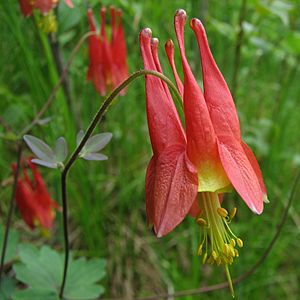Canadian columbine facts for kids
Quick facts for kids Canadian columbine |
|
|---|---|
 |
|
| Conservation status | |
| Scientific classification | |
| Genus: |
Aquilegia
|
| Species: |
canadensis
|
The Canadian columbine (Aquilegia canadensis), also known as Canada columbine or wild columbine, is a beautiful flowering plant. It belongs to the buttercup family called Ranunculaceae. This plant is a perennial herb that grows naturally in woodlands and rocky areas across eastern North America. People love it for its bright red and yellow flowers. It can easily mix with other Aquilegia species to create hybrid plants.
Contents
Discovering the Canadian Columbine
This plant usually grows to be about 15 to 90 centimeters (6 to 35 inches) tall. Its leaves look a bit like ferns and are grouped in threes. They grow from the bottom of the plant and also along the flowering stems.
Its Unique Flowers
The flowers are about 1 to 2 inches (2.5 to 5 cm) long. They have bright yellow petals and a red spur. The sepals, which are like small leaves protecting the flower, are also red. These nodding flowers usually appear in late spring, around May and June, above the leaves.
The round end of the spur holds sweet nectar. This nectar is a favorite treat for butterflies and hummingbirds. These animals help the plant by carrying pollen from one flower to another.
Who Eats the Leaves?
The caterpillars of a moth called the Columbine Duskywing (Erynnis lucilius) love to eat the leaves of the Canadian columbine.
Growing Canadian Columbine
The Canadian columbine is a very popular plant for gardens. People value it for its pretty leaves and eye-catching flowers. It is grown widely in many temperate parts of the Northern Hemisphere, even outside its natural home. In the UK, it used to have a special award called the Royal Horticultural Society's Award of Garden Merit. Now, it is more likely recognized for helping pollinators.
Planting and Care
It is quite easy to grow this plant from seeds. If you plant seeds, the flowers will usually bloom in the second year. Once planted, it can live for a long time in a garden. It grows well in shady spots, but it can also grow in sunny areas if it gets enough water.
There is a special type of Canadian columbine called 'Little Lanterns'. This plant only grows to about half the height of the regular species.
Traditional Uses of the Plant
Some Native American tribes used different parts of the red columbine as traditional remedies. They used it to help with various problems like headaches, sore throats, and fevers. They also used it for rashes, mouth sores, kidney issues, and even heart problems.
Native American men sometimes rubbed crushed seeds on their hands. They believed this would act as a love charm.
Is it Safe to Eat?
The Canada columbine contains a substance called a cyanogenic glycoside. This means that if the plant is damaged, it can release poisonous hydrogen cyanide. So, it is important to know that this plant is not safe to eat.
Where Does it Grow?
The Canadian columbine grows naturally in many parts of the United States and Canada.
In the USA
It can be found in states like Alabama, Arkansas, Connecticut, Delaware, Florida, Georgia, Iowa, Illinois, Indiana, Kansas, Kentucky, Massachusetts, Maryland, Maine, Michigan, Minnesota, Missouri, Mississippi, North Carolina, North Dakota, Nebraska, New Hampshire, New Jersey, New York, Ohio, Oklahoma, Pennsylvania, Rhode Island, South Carolina, South Dakota, Tennessee, Texas, Virginia, Vermont, Wisconsin, West Virginia, and Washington D.C.
In Canada
In Canada, it grows in Manitoba, New Brunswick, Ontario, Quebec, and Saskatchewan.
Wetland Indicator Status
Wetlands are very important natural areas, but they are limited. The Wetland Indicator Status helps scientists figure out if a certain area is a wetland. This is done by looking at the types of native plants that grow there. If a plant grows well in a certain spot, it can mean that there is a higher chance of a wetland being there. The Canadian columbine is one of these helpful plants.
- Regions 1-5: In these regions, the Canadian columbine is considered "Facultative Equally" (FAC). This means it is equally likely to grow in wetlands or in areas that are not wetlands.
- Region 6: In this region, it is called "Facultative Wetland" (FACW). This means it usually grows in wetlands, but you might sometimes find it in non-wetland areas too.
Gallery
-
A close-up of the flower and a seedpod.
See also
 In Spanish: Aquilegia canadensis para niños
In Spanish: Aquilegia canadensis para niños







